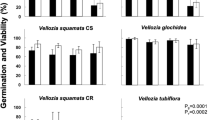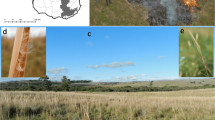Abstract
Fire has been shown to stimulate seed germination in a number of fire-prone ecosystems, mainly in Mediterranean type shrublands and, though not exclusively, in hardseeded species. Stimulation by heat, or by chemical constituents of charred wood and smoke, have been identified as the main mechanisms breaking dormancy of soil-stored seeds. In this study, we experimentally tested the effect of heat on germination rates of nine herbaceous species (5 grasses, 1 Cyperaceae, 3 forbs) from frequently burned grassland in southern Brazil. Seeds were exposed to temperatures between 50°C and 110°C (to 180°C for two species) for 2 min. Germination of treated seeds was monitored in a germination chamber. The heat treatments did not stimulate germination in any of the species tested. Tolerance of seeds to heat varied between species. Two of the herbs and the three grasses with the smallest seeds were able to germinate at temperatures of 110°C, or even higher. Apparently, no mechanisms directly stimulating germination by heat have developed in herbaceous species from southern Brazil. However, survival of high temperatures can be considered to be an adaptation to fire, possibly allowing for increased germination in the post-burn environment.
Similar content being viewed by others
References
Auld T.A., O’Connell M.A. (1991). Predicting patterns of post-fire germination in 35 eastern Australian Fabaceae. Australian Journal of Ecology 16:53–70
Baskin C.C., Baskin J.M. (1998a). Ecology of seed dormancy and germination in grasses. In: Cheplick G.P. (eds). Population biology of grasses. Cambridge University Press, Cambridge, pp. 30–83
Baskin C.C., Baskin J.M. (1998b) Seeds Ecology, biogeography, and evolution of dormancy and germination. Academic Press, San Diego
Behling H., Pillar V.D., Orlóci L., Bauermann S.G. (2004) Late Quaternary Araucaria forest, grassland (Campos), fire and climate dynamics, studied by high resolution pollen, charcoal and multivariate analysis of the Cambará do Sul core in southern Brazil. Palaeogeography, Palaeoclimatology, Palaeoecology 203:277–297
Bell D.T., King L.A., Plummer J.A. (1999) Ecophysiological effects of light quality and nitrate on seed germination in species from Western Australia. Aust. J. Bot. 19:276–282
Benson E.J., Hartnett D.C., Mann K.H. (2004) Belowground bud banks and meristem limitation in tallgrass prairie plant populations. American Journal of Botany 91:416–421
Boldrini I.B. 1993. Dinâmica da vegetação de uma pastagem natural sob diferentes niveis de oferta de forragem e tipos de solos, Depressão Central, RS. Doutorado em Zootecnia, PhD thesis, Faculdade de Agronomia, UFRGS, Porto Alegre, RS
Boldrini I.B. 2002. Campos sulinos: caracterização e biodiversidade. In: Araújo E.d.L., Noura A.d.N., Sampaio E.V.d.S.B., Gestinari L.M.d.S. and Carneiro, J.d.M.T. (ed.) Biodiversidade, conservação e uso sustentável da flora do Brasil. Universidade Federal Rural de Pernambuco, pp. 95–97
Bond W.J., van Wilgen B.W. (1996) Fire and plants. Chapman and Hall, London
Bradstock R.A., Auld T.A. (1995) Soil temperatures during experimental bushfires in relation to fire intensity: consequences for legume germination and fire management in south-eastern Australia. Jour. Appl. Ecol. 31:76–84
Cheplick G.P. (2000). Seed disperals and seedling establishment in grass populations. In: Cheplick G.P. (eds), Population biology of grasses. Cambridge University Press, Cambridge, pp. 84–105
Christensen N.L. (1985) Shrubland fire regimes and their evolutionary consequences. In: Pickett S.T.A., White P.S. (eds), The ecology of natural disturbance and patch dynamics. Academic Press, Orlando, pp. 85–100
Christensen N.L., Muller C.H. (1975). Effects of fire on factors controlling plant growth in Adenostena chaparral. Ecological Monographs 45:29–55
Cruz A., Pérez B., Velasco A., Moreno J.A. (2003) Variability in seed germination at the interpopulation, intrapopulation and intraindividual levels of the shrub Erica australis in response to fire-related cues. Plant Ecology 169:93–103
Ferrandis P., Herranz J.M., Martínez-Sánchez J.J. (1999) Effect of fire on hard-coated Cistaceae seed banks and its influence on techniques for quantifying seed banks. Plant Ecology 144:103–114
Garcia E.N., Boldrini I.B., Jacques A.V.A. (2002) Dinâmica de formas vitais de uma vegetação campestre sob diferentes práticas de manejo e exclusão. Iheringia, Ser. Bot. 57:215–241
Gashaw M., Michelsen A. (2002) Influence of heat shock on seed germination of plants from regularily burnt savanna woodlands and grasslands in Ethiopia. Plant Ecology 159:83–93
Ghermandi L., Guthmann N., Bran D. (2004) Early post-fire succession in northwestern Patagonia grasslands. J. Veg. Sci. 15:67–76
Gill A.M. 1981. Fire adaptive traits of vascular plants. In: Mooney H.H., Bonnicksen N.L., Christensen N.L., Lotan J.E. and Reiners W.A. (eds), Fire Regimes and Ecosystem Properties, United States Forest Service, General Technical Report WO-26, pp. 208–230
González-Rabanal F., Casal M. (1995) Effect of high temperatures and ash on germination of ten species from gorse shrubland. Vegetatio 116:123–131
Hanley M.E., Fenner M. (1997) Seedling growth of four fire-following Mediterraneaen plant species deprived of single mineral nutrients. Functional Ecology 11:398–405
Hanley M.E., Fenner M. (1998) Pre-germination temperature and the survivorship and onward growth of Mediterranea fire-following plant species. Acta Oecologica 19:181–187
Hanley M.E., Lamont B.R. (2000) Heat pre-treatment and the germination of soil- and canopy-stored seeds of south-western Australian species. Acta Oecologica 21:315–321
Hanley M.E., Unna J.E., Darvill B. (2003) Seed size and germination response: a relationship for fire-following plant species exposed to thermal shock. Oecologia 134:18–22
Herranz J.M., Ferrandis P., Martínez-Sánchez J.J. (1998) Influence of heat on seed germination of seven Mediterranean Leguminosae species. Plant Ecology 136:95–103
Keeley S.C., Keeley J.E., Hutchinson S.M. (1981) Postfire succession in the herbaceous flora in southern California chaparral. Ecology 62:1608–1621
Keeley J.E., Morton B.A., Pedrosa A., Trotter P. (1985) Role of allelopathy, heat, anc charred wood in the germination of chaparral herbs and suffrutescents. J. Ecol. 73:445–458
Keeley J.E., Bond W.J. (1997). Convergent seed germination in South African fynbos and Californian chaparral. Plant Ecology 133:153–167
Keeley J.E., Fotheringham C.J. (2000) Role of fire in regeneration from seed. In: Fenner M. (eds), Seeds: the ecology of regeneration in plant communities. CABI International, Wallingford, pp. 311–330
Klein R.M. (1975) Southern Brazilian phytogeographic features and the probable influence of upper quaternary climatic changes in the floristic distribution. Bol. Paranaense Geociências 33:67–88
Martin R.E., Miller R.L., Cushwa C.T. (1975) Germination response of legume seeds subjected to moist and dry heat. Ecology 56:1441–1445
Martínez-Sánchez J.J., Marin A., Herranz J.M., Ferrandis P., De las-Heras J. (1995). Effects of high temperatures on germination of Pinus halepensis Mill. and P. pinaster Aiton subsp. pinaster seeds in southeastern Spain. Vegetatio 116:73–83
Mendonça R.C.d., Felfili J.M., Walter B.M.T., da Silva M.C. Jr., Reyende A.V., Filgueiras T.S., Nogueira P.E. (1998) Flora vascular do Cerrado. In: Sano S.M., de Almeida S.P. (eds), Cerrado: ambiente e flora. Embrapa, Planaltina, DF pp. 289–556
Miranda A.C., Miranda H., Dias O.d.F., Dias B.F.d.S. (1993) Soil and air temperatures during prescribed cerrado fires in Central Brazil. Jour. Tropical Ecology 9:313–320
Moreno J.M., Oechel W.C. (1991). Fire intensity effects on germination of shrubs and herbs in southern California chaparral. Ecology 72:1993–2004
Morgan J.W. (1999) Defining grassland fire events and the response of perennial plants to annual fire in temperate grassland of southern Australia. Plant Ecology 144:127–144
Mott J.J., Groves R.H. (1982) Germination strategies. In: Pate J.S. (eds), The biology of Australian plants. University of Western Australia Press, Nedlands, pp. 307–341
Naveh Z. (1975) The evolutionary significance of fire in the Mediterranean region. Vegetatio 29:199–208
Overbeck G., Müller S.C., Pillar V.D. and Pfadenhauer J. in press. Floristic composition, environmental variation and species distribution patterns in a burned grassland in southern Brazil. Braz. J. Biol.
Overbeck G. and Pfadenhauer J. submitted. Adaptive strategies in burned subtropical grassland in southern Brazil. Flora
Pierce S.M., Moll E.J. (1994) Germination ecology of six shrubs in fire-prone Cape fynbos. Vegetatio 110:25–41
Pillar V.D. 2004. MULTIV: Multivariate Exploratory Analysis, Randomization Testing and Bootstrap Resampling. User’s Guide v. 2.3.10. Departamento de Ecologia, UFRGS, Porto Alegre, RS, Brazil. http://ecoqua.ecologia.ufrgs.br
Pillar V.D., Quadros F.L.F. (1997). Grassland-forest boundaries in southern Brazil. Coenoses 12:119–126
Reyes O., Casal M., Trabaud L. (1997). The influence of population, fire and time of dissemination on the germination of Betula pendula seeds. Plant Ecology 133:201–208
Segura A.M., Holmgren M., Anabalón J.J., Fuentes E.R. (1998) The significance of fire intensity in creating local patchiness in the Chilean matorral. Plant Ecology 139:259–264
Silva J.F., Raventos J., Caswell H. (1990) Fire and fire exclusion effects on the growth and survival of two savanna grasses. Acta Oecologica 22:783–800
Thanos C.A., Georghiou K. (1988). Ecophysiology of fire-stimulated seed germination in Cistus incanus ssp creticus (L.) Heywood and C. salvifolius L. Plant, Cell and Environment 11:841–849
Tyler C.M. (1995). Factors contribution to postfire seedling establishment in chaparral: direct and indirect effects of fire. J. Ecol. 83:1009–1020
Whelan R.J. (1986). Seed dispersal in relation to fire. In: Murray D.R. (eds), Seed dispersal. Academic Press, San Diego, pp. 237–271
Williams P.R., Congdon R.A., Grice A.C., Clarke P.J. (2003). Fire-related cues break seed dormancy of six legumes of tropical eucalypt savannas in north-eastern Australia. Austral Ecology 28:507–514
Zacharias P.J.K., Tainton N.M., Oberholster C. (1988). The effect of fire on germination in five common veld grasses. J. Grassl. Soc. Sth. Afr. 5:229–230
Acknowledgements
We would like to thank Prof. Dr. Renato Borges de Medeiros and Profa. Dra. Lucia Brandão Franke, both UFRGS Department of Agronomy, for their help and for the opportunity to use equipment at the UFRGS seed laboratory. Further thanks go to Emiliano Santarosa and Alessandra Fidelis for helping with the experiments. An anonymous reviewer gave stimulating comments on the manuscript. G. O. received a PhD scholarship from the German National Academic Foundation, S.M. a CAPES PhD grant, and V.P. CNPQ support. This study received support from the German DFG, CAPES (Brazil) and DAAD (Germany) under a ProBral-cooperation.
Author information
Authors and Affiliations
Corresponding author
Rights and permissions
About this article
Cite this article
Overbeck, G.E., Müller, S.C., Pillar, V.D. et al. No heat-stimulated germination found in herbaceous species from burned subtropical grassland. Plant Ecol 184, 237–243 (2006). https://doi.org/10.1007/s11258-005-9068-1
Received:
Accepted:
Published:
Issue Date:
DOI: https://doi.org/10.1007/s11258-005-9068-1




